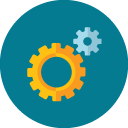
Change Management Articles
When it comes time to make changes, the best managers direct the transition from start to finish. How have leaders managed change successfully?
The rapid pace of transformation will affect every industry eventually, and many are already feeling the pinch. Success will come to businesses that disrupt themselves.
When you work in a business setting, you’re forced to confront the challenge of working with people of varying opinions ranging from how the business plan should be run to what kind of creamer should be available for morning coffee.
Disruptive technologies are forever changing the way employees work and organizations function. Automation is helping manufacturers reach record-high levels of production. Wearable devices are redefining doctor-patient relationships. And lawyers are using data analytics to predict case outcomes.
As the connection between senior leadership and frontline staff, mid-level managers are a critical resource for change management. However, if you don’t engage them effectively, these team leads can become a sticking point instead, leading to inefficient roll-out and disinterested staff.
Employee engagement videos have revolutionized the way human resource departments conduct business. If part of HR’s job is to ensure all employees have the ability to collaborate and communicate with each other and their superiors, then employee engagement software is a vital tool to open employee communication lines and build expectations.
Change management is often overlooked as a crucial component of any corporate structure. Most managers and business leaders believe that the time to bring in a change agent is when processes are broken, communications have ground to a halt, and the company is losing business. But effective change management needs time and room to grow, and may need to be initiated before cracks appear on the surface.
The thing about change management is that it involves a lot of invisible work that’s hard to follow from the outside. The two things that people see in change management are the change (toward the end, if they are paying attention) and when it goes (sometimes horribly) wrong.
It's a new year, and that means a new beginning. We resolve to lose weight, exercise more, drink less and countless other things in our personal lives. But, it's also an opportune time to focus on organizational resolutions.
Artificial intelligence (AI) can have a profound effect on making businesses more productive, and HR teams are uniquely poised to benefit from it. But actually adopting and implementing AI can be a daunting task, and many teams aren’t quite sure where to begin. It’s easy to get overwhelmed (and confused) by the volume of literature out there. But the fact of the matter is that the workplace is shifting at an extremely rapid rate and business leaders need to be asking themselves how, not if, they are going to implement AI.
Change management is a necessary and sometimes messy part of HR’s job within any organization. These days, workplaces and companies have to change quickly or be left behind. Employee communications initiatives and software tools can help, but studies show that the best way to engage your employees and move them through transition is with coaching.
I am not a psychologist or psychiatrist, but I have stayed at many Holiday Inns in my time. That, and a bit of my own historical references allow me to have the following opinion. My premise is this: the HR/Employee relationship is dysfunctional and almost surely codependent.
My elementary-aged children didn’t have school on Election Day. As a working parent, random school holidays require me to figure out alternative childcare or use a vacation day. Fortunately, I currently work from home so my son, daughter, and nephew can pile up the blankets and pillows, build a fort, and play video games. I’m able to work on work projects while caring for (and yet ignoring) the kids.
Millennials have come of age in a layoff culture, so their understanding of loyalty isn’t based on a sense of job security. They crave a clear career path, mentoring, training, and other learning opportunities.
Certain skills will be required to succeed in the Fourth Industrial Revolution. Here are four recommendations to help bridge the youth skills gap.
Employers should take a forward-looking perspective in considering ideal candidates, and rather than focus on what people have done in the past, consider ways to understand how a person learns.
Often, too often, corporate culture turns toxic and entrenches itself so deeply that the organization can no longer serve its purpose effectively. This usually initiates the most painful form of change management. You're the new kid on the block, new C-suite or director or someone else with some ability to make changes to policy and employee communications standards – maybe you were even hired specifically to do that. What do you do about it? Bear with me for a brief history lesson.
I just finished six weeks of international travel so I’ve been spending a lot of time thinking about sleep, exercise, and diet. (Yes I’m taking good care of myself, but it does really take an effort.) What I want to talk about is the well-being market, which is something that has come up in every city I visited. I’ll be publishing a more detailed research report on this market later in the year, but right now I want to share some information which you may find useful.
Leadership is changing. The digital and VUCA (Volatile, Uncertain, Complex and Ambiguous) world is turning old models on their heads. How can you keep up? There is no shortage of advice about how to lead a digital transformation project. But business strategist Amit Mukherjee goes further, exploring how the absorption of digital technologies is fuelling this transformation.
Kathy Gallo, senior vice president and CLO of Northwell Health, says her learning delivery strategy changes as the organization changes. She expects learning delivery methods to continue changing and improving in the next five to 10 years with increasing knowledge about the science of learning.
Communicators can become indispensable bridge builders by listening to employees, confronting biases and standing up for what’s right.






















